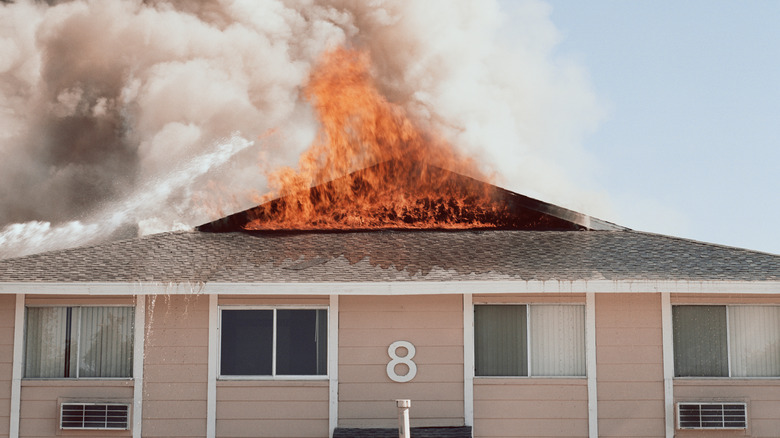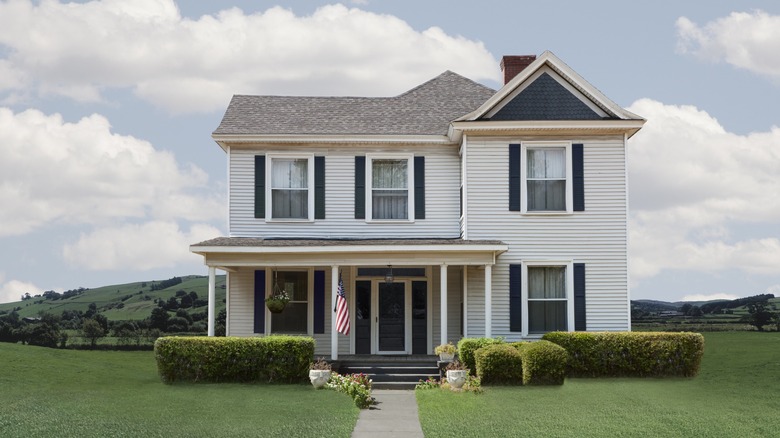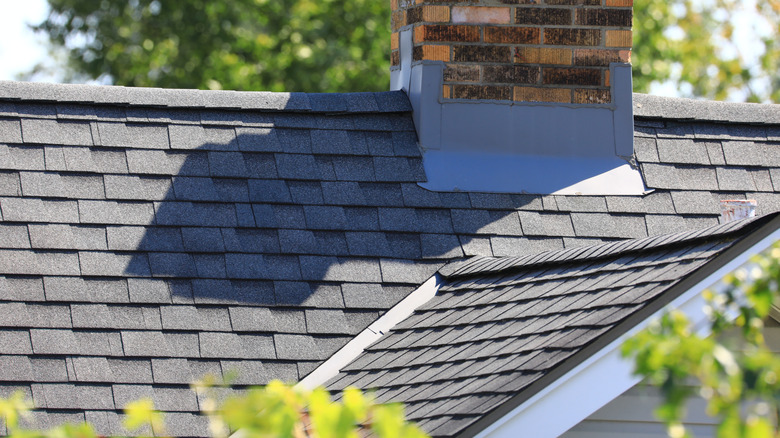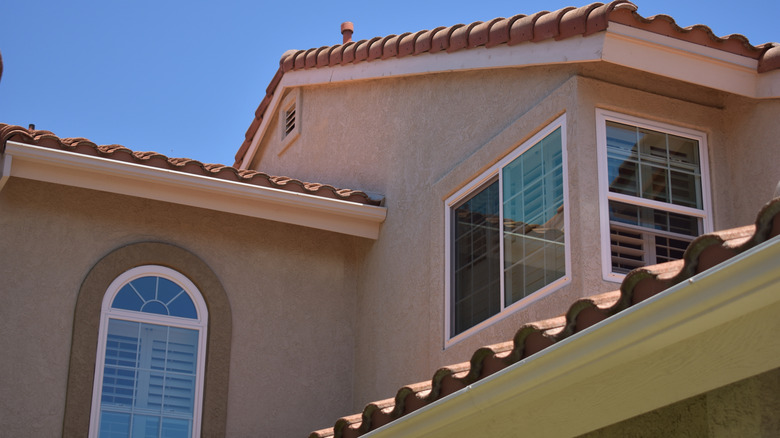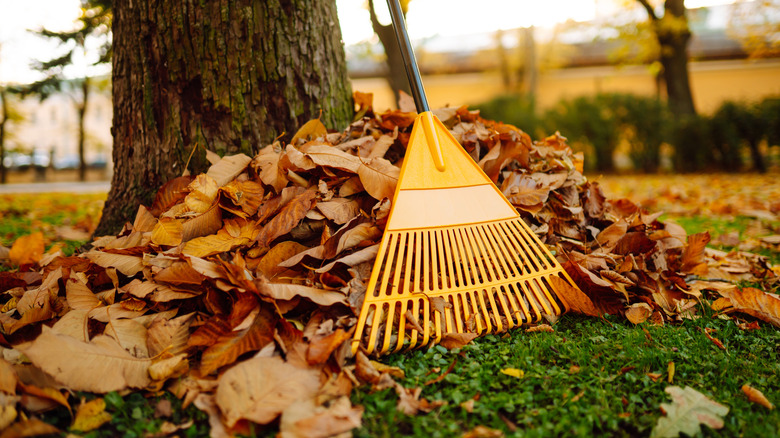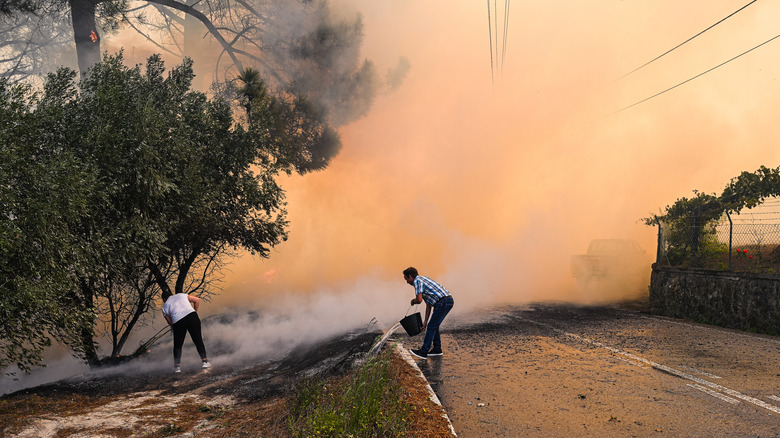Protect Your Home From Wildfires With Our Key Tips
We may receive a commission on purchases made from links.
There are times when a fire can get out of control and cause harm to the landscape, people, animals, and personal property. It doesn't matter whether a wildfire is started because of a lightning strike or thanks to someone who didn't take proper precautions to prevent wildfires while spending time outdoors, it can quickly spread and race toward homes. If your home is at risk for wildfires, it's important to make sure you take proper precautions to ensure you minimize the risk as much as possible. You can't stop the fire single-handedly, but you can do your part to slow it down and potentially keep your property safe until firefighters can take steps to contain the flames.
Unfortunately, it isn't always easy to mitigate fire. It involves drastically changing the design of your yard and creating property that doesn't quite match what people think of when they imagine the perfect lawn and garden. If you want to be as fireproof as possible, you may need to go as extreme as changing the material of your home and cutting down a few of your favorite plants.
Create a defensible space to slow down fires coming your way
This step is probably one of the biggest ones. Fire mitigation groups recommend breaking up your yard into three zones. The first is the area within five feet of your home. Here, the best way to prevent fire is to keep everything flammable far away. This means no overhanging branches and nothing stored under your porch or deck. You also want to keep trees, and flammable materials like grass, flammable plants, and mulch clear of this area. Using rocks, sand, cement, or other flame-resistant materials in the zone is best. Thankfully, there are some pretty clever alternatives to grass for a no-mow garden.
The second zone goes from 6 to 30 feet. In this area, grass shouldn't be allowed to be much above 4 inches. Additionally, it's a good idea to cut tree branches so the lowest is about 10 feet high. You also want to thin trees so the crowns, or the tops, are at least 10 feet apart. You will also want to be vigilant for plants that can create a ladder for the fire, like moss, tall bushes, and vines, and trim those. The final zone, up to 100 feet from the house, is where you want to focus on getting rid of large flammables like logs, thinning out trees, and ladder elements. If you're having problems planning it out, sometimes starting from a clean slate can be the best option, and is one of a few simple yard maintenance tips Erin Napier swears by.
Make sure your roof is sturdy and has no missing or loose shingles
In neighborhoods closer to the great outdoors, homes catching fire due to flying embers is a common occurrence. This is why making sure your roof is fully sealed and fire-resistant is so important. Even if the main fire isn't close to your home, embers can travel over a mile and light up structures. There are many different types of roofing materials, and some are more resistant to flames than others. If you're worried about embers getting on your roof, you can choose from several of the materials that are resistant to fire, including aluminum, brick, stone, iron, slate, or tile. Avoid materials such as shake-shingles. Also, you want to take the time to ensure your roof is cleaned off and your gutters are emptied regularly.
If you do have any broken or loose shingles or tiles on your roof, it's also a good idea to get those replaced so that everything is closed up as it should be and there are no places for loose embers to get in and start a fire. If the roof has areas that aren't sealed properly, fire-resistant caulk, silicone, mortar, or expanding foam made to handle flames are all options, especially if you don't have the time or money to fix your roof fully.
Spend extra on materials resistant to embers
In addition to a fire-resistant roof, you need to think about making the rest of your home able to withstand flames and embers as well. There are several areas to consider changing. For example, if you have screens, like for windows or a porch, swap out the vinyl using other materials like aluminum to reduce the chances of them going up in flames if embers land on them.
Siding on your home may need to be replaced as well. Consider using something like cement or stucco. There are also options for wood that has been specially treated to stand up against flames.
For windows, you can use fire-resistant seals around the frame. There are also options for window coverings that will help protect the glass from the heat of the flames. If you don't mind replacing your windows, consider switching to tempered glass. This is the type usually used in showers and fireplaces as it's able to withstand heat and changing temperatures a bit better than standard glass.
Install a barrier between you and potential fires
Fences can help slow down fires, and even prevent further spreading of embers downwind if done right. However, you can't use just any old fence. Classic wood fences will only help spread the flame and embers, and iron is usually too thin to actually act as a preventative. The two best options are fiber cement and steel. However, as it costs several thousand dollars to install a wooden privacy fence in your backyard, not everyone can afford the even more expensive cement and steel options.
If you can't install a full fence, or you just don't want to, you can create an invisible barrier instead. Fire breaks are landscapes designed to prevent flames from continuing in that direction. Roads, pre-burned earth, or certain plants can act as a break and significantly slow down the spread of fire to your home. This isn't feasible for everyone, as they require a lot of space, but if you live in a large open area or a forest with a lot of land, a fire break can be significant protection.
For roads and plowed breaks, you want at least 10 feet of bare earth, as well as space between the crowns of trees. This slows down all kinds of fires. If you're doing a pre-burned path, you want at least a 20-foot strip of charred land with large flammable objects like logs removed beforehand. Finally, for vegetation, cool-season grasses and legumes are your best preventative options. The area must be cleared of other vegetation and needs to be at least 50 feet wide. They are a lot more work than building a fence and need regular maintenance, but they can keep your yard and view open.
Keep up with the work
This may all sound like a lot of work, but it is necessary. Most of the steps above aren't something you can do just once and expect to save your property. Regular maintenance is necessary to keep your home as safe as possible from fires.
Cleaning out gutters is a chore that should happen a minimum of twice a year, but may be necessary more often depending on how much debris ends up on your roof and fills the gutters. Your chimney, if you have one, only needs to be cleaned once a year, though you can do it more frequently. Inspecting and trimming back trees is also something that should be done roughly once a year.
Grass needs to be mowed regularly — any time it grows too much above four inches – generally once a week. However, if you want to mitigate fire risks and have a nice-looking lawn, you can follow certain mowing rules for a luscious green yard. You also need to keep it healthy and alive. Dry grass catches fire easily, which can help flames spread to your home and even get stronger. Water your yard for about 30 minutes once or twice a week for best results. In the fall and winter, this can be cut back, or even dropped entirely, depending on the climate where you live. Leaves and branches can be picked up whenever they start to accumulate, which could be as often as every three or four days during fall. When you're out raking and cleaning, it's also a good idea to just give your yard a quick visual inspection. Make sure you don't have old stuff lying around, or flammable objects too close to the house.
Methodology
When it comes to all of our above tips, each one is backed by groups, governments, and organizations aimed at reducing the spread of fires once they start. That includes the National Interagency Fire Center, the Colorado State Forest Service, The National Fire Protection Association, and Cal Fire. Extensive research on fire mitigation has been done, and the key tips are the results of these studies. There are plenty of other minor preventative methods to try as well, but when it comes to saving your home, bigger changes are better and more effective.
